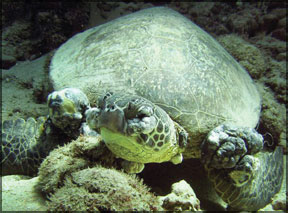Sea Turtle herpes tumors linked to sewage
Tumors that have plagued green sea turtles worldwide for decades may
be caused by pollution, a new study says.
Nitrogen-rich runoff from sewers and farms is fueling a rise in
invasive seaweed that, when consumed by the reptiles, may trigger an
otherwise dormant herpes virus. This virus in turn causes the often
fatal growths.
|

turtle tumors |
The cauliflower-like tumors - which can sprout on a turtle's eyes,
mouth, joints, and internal organs - have contributed to declines in the
4-foot-long (1.2-meter-long) turtles. Listed as endangered by the
International Union for Conservation of Nature, green sea turtles are
found in the world's tropical and subtropical waters.
In some parts of Hawaii, where green sea turtle strandings occur
regularly, as many as 90 percent of stranded dead or dying turtles
discovered have been afflicted with the disease, according to study
leader and an ecologist with the National Oceanic and Atmospheric
Administration's Pacific Islands Fisheries Science Center in Honolulu
Kyle Van Houtan.
Wherever the turtle strandings occur, there is often evidence of
sewage and invasive algae, Van Houtan said.
Until now, however, hard evidence that pollution factors into the
turtles' disease has remained elusive, he noted.
Polluted areas are Turtle-tumor hot spots
Van Houtan and colleagues analyzed human activities on land to
calculate a "nitrogen footprint" for each watershed - an area that
drains into a water body - on the Hawaiian islands of Oahu, the Big
Island, and Maui. The team also studied 28 years' worth of data on green
sea turtle strandings on the islands.
Comparing the two data sets, the scientists found that diseased
turtles strand more in areas with high nitrogen runoff from agriculture,
sewers, and cities.
These turtle-tumor hot spots are "the places that I wouldn't
necessarily want to go surfing after a rain ... because of the nasty
stuff that would show up" in the ocean, Van Houtan added.
Nitrogen awakens herpes viruses
The scientists don't think the nitrogen-loaded runoff causes tumors
directly. Instead, there may be a chain of interactions that starts with
a nitrogen-fed boom in nonnative seaweed, at least in Hawaii.
Nitrogen acts as a fertilizer in oceans, and is a main cause of
oxygen-sucking algae blooms called dead zones.
Around the Hawaiian islands, several seaweed species were either
accidentally introduced or deliberately harvested for food crops and
later "escaped" cultivation and spread into the wild.
For instance, hookweed - native to the Mediterranean, the Caribbean,
the Indian Ocean, and the Philippines - was introduced to Hawaii in
1974. Gorillo ogo and spiny seaweed came from the Pacific and Indian
Oceans and Guam, respectively.
The seaweed absorbs the extra nitrogen and converts it into an amino
acid - the building block of protein - called arginine. When turtles eat
the seaweed, arginine awakens dormant herpes viruses in the turtles'
bodies that generate the tumors.
It's possible that nonnative seaweed in Hawaii is better than native
seaweed species at converting nitrogen to arginine, Van Houtan noted.
And because Hawaiian green sea turtles now rely on the invasive
seaweed for food, Van Houtan suspects the animals get dosed with
tumor-triggering amino acids at every meal.
Turtle tumors have other causes
Wildlife epidemiologist with the environmental nonprofit EcoHealth
Alliance in New York Alonso Aguirre, praised the study for confirming
the link between pollution and sea turtle tumors.
But he also said that the tumors' cause may be more complicated.
The pollution-virus link is "a very simplistic pathway to explain the
whole disease," Aguirre said, adding he suspects other factors, such as
water temperature, and possibly additional viruses, are at play.
Regardless of exactly how the tumors form, Aguirre said the study shows
that "the turtles ... are telling us that something is happening to the
oceans in a way that now, we have to pay attention."
National Geographic news |



